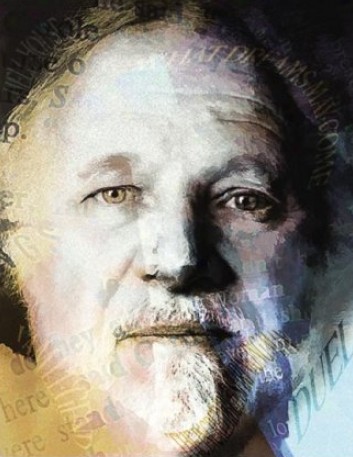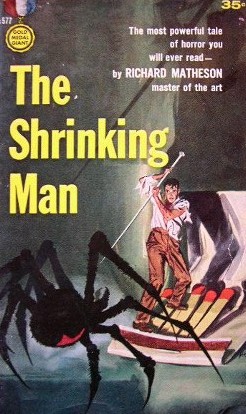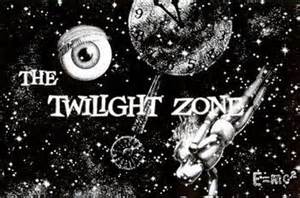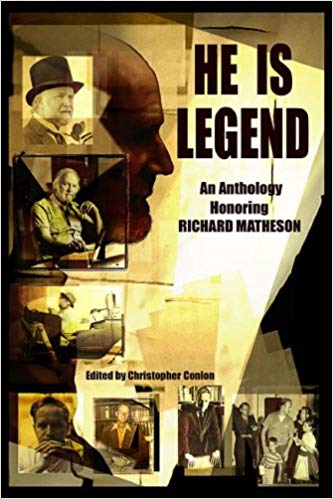 What made the late novelist/screenwriter Richard Matheson great? A number of factors, I’d say, including a genius for inventive and absorbing narratives, a sure grasp of characterization and a thoroughly unique, and uniquely relentless, brand of paranoid horror—or to use Matheson’s preferred term, terror—that has impacted the genre as thoroughly as the fiction of Poe, Lovecraft or Stephen King.
What made the late novelist/screenwriter Richard Matheson great? A number of factors, I’d say, including a genius for inventive and absorbing narratives, a sure grasp of characterization and a thoroughly unique, and uniquely relentless, brand of paranoid horror—or to use Matheson’s preferred term, terror—that has impacted the genre as thoroughly as the fiction of Poe, Lovecraft or Stephen King.
It was King who famously cited Matheson as his biggest influence, having written that “without Richard Matheson, I wouldn’t be around.” And the superlatives from Matheson’s fellow horror/sci fi scribes don’t stop there: according to William F. Nolan, “Like the Good Housekeeping seal of approval, the byline of Richard Matheson has always been a guarantee of true excellence,” while Harlan Ellison claimed “He is the writer of whose work one finds oneself most often saying “God, I wish I’d written that,” and Dennis Etchison gushed that “(Matheson) is the very best of us, an archetype of what such a (writing) career is supposed to be all about.”
It was King who famously cited Matheson as his biggest influence, having written that “without Richard Matheson, I wouldn’t be around.”
Richard Matheson’s brand of horror was far removed from the old-dark-castle scares of old, with protagonists who bore little resemblance to the eccentric and/or psychotic characters who previously typified the genre. Quite simply, it was the ordinariness of Matheson’s universe that made his horrors so scary. See the fifties era classics I AM LEGEND and THE SHRINKING MAN for standout examples, as well as A STIR OF ECHOES, EARTHBOUND and the short stories “Born of Man and Woman,” “Duel,” “Prey,” “Dance of the Dead,” “Button, Button” and “Nightmare at 20,000 Feet,” all of which show that when working at full blast Matheson wasn’t merely a great horror writer but a great writer period.
We can add to that distinguished list the suspense novels SOMEONE IS BLEEDING and RIDE THE NIGHTMARE, and also THE BEARDLESS WARRIORS, a powerful autobiographical account of Matheson’s stint as an infantryman in WWII. In his later years Matheson branched out even further with the paranormal romance novels BID TIME RETURN (a.k.a. SOMEWHERE IN TIME) and WHAT DREAMS MAY COME. Neither is a favorite of mine, although in their overwhelming sappiness and sentimentality both novels show that Matheson never did anything half way. For a further example of that tendency see 1971’s intense haunted house novel HELL HOUSE, which despite Matheson’s oft-stated distaste for gory horror pulls no punches in its graphic approach, being the first true splatterpunk novel.
In his final years Matheson remained active, turning out a string of western novels that included JOURNAL OF THE GUN YEARS, THE GUNFIGHT and THE MEMOIRS OF WILD BILL HICKOCK. There was also the suspenseful wilderness thriller HUNTED PAST REASON (not his best work, but still a fine, taut read), and a handful of previously drafted manuscripts that finally saw publication in the early ‘00s, courtesy of Gauntlet Press: HUNGER AND THIRST, the children’s novel ABU AND THE 7 MARVELS and COME FYGURES, COME SHADOWS.
 Of course, the above covers only Matheson’s literary output. His work in film and television was even more prolific, and equally important. It was Matheson’s scripts for the original TWILIGHT ZONE that, along with those of Charles Beaumont and Rod Serling, provided that program’s signature style of eerie reality displacement topped off with surprise endings. That style came directly from Matheson’s fiction, which tended to adapt remarkably well to the screen. That was the case with “Little Girl Lost,” “Nightmare at 20,000 Feet” and “Steel,” which were adapted into three especially memorable TZ episodes.
Of course, the above covers only Matheson’s literary output. His work in film and television was even more prolific, and equally important. It was Matheson’s scripts for the original TWILIGHT ZONE that, along with those of Charles Beaumont and Rod Serling, provided that program’s signature style of eerie reality displacement topped off with surprise endings. That style came directly from Matheson’s fiction, which tended to adapt remarkably well to the screen. That was the case with “Little Girl Lost,” “Nightmare at 20,000 Feet” and “Steel,” which were adapted into three especially memorable TZ episodes.
To list all of Matheson’s TV and film credits would take far more space than I’ve got here. Suffice it to say that he wrote for TV programs like CHEYENNE, THRILLER, LAWMAN, COMBAT!, THE OUTER LIMITS, THE ALFRED HITCHCOCK HOUR, STAR TREK, NIGHT GALLERY and AMAZING STORIES (that’s only a partial list), and scripted movies that spanned several milestones in the field of horror cinema.
Matheson’s screenwriting career began in the tail end of the Universal horror boom with THE INCREDIBLE SHRINKING MAN, and segued into the AIP drive-in age with the Roger Corman directed Edgar Allen Poe inspired productions HOUSE OF USHER, THE PIT AND THE PENDULUM, THE RAVEN and others. Matheson also scripted a Hammer production, THE DEVIL RIDES OUT, before finding success in the early seventies TV movie arena with three of the most popular TVMs—the Steven Spielberg directed DUEL (later padded out for big screen exhibition), THE NIGHT STALKER and TRILOGY OF TERROR—as well as a host of lesser known efforts like DYING ROOM ONLY, MOON OF THE WOLF and THE MORNING AFTER. From there he segued into big budget Hollywood productions like JAWS 3-D, TWILIGHT ZONE: THE MOVIE and LOOSE CANNONS.
Matheson didn’t do much screenwriting in his final years, but that didn’t staunch the movie adaptations. I know of no greater testament to the strength and longevity of Richard Matheson’s work than the fact that in the last 20 years of his life he had several major movies adapted from his work, including WHAT DREAMS MAY COME, A STIR OF ECHOES, I AM LEGEND, THE BOX (from “Button, Button”) and REAL STEEL (from “Steel”). H is influence is further evident in WORLD WAR Z and THE WALKING DEAD, both of which have their genesis in I AM LEGEND.
is influence is further evident in WORLD WAR Z and THE WALKING DEAD, both of which have their genesis in I AM LEGEND.
Not all those movies are especially good, mind you, and neither were previous Matheson adaptations like THE OMEGA MAN, THE LEGEND OF HELL HOUSE or SOMEWHERE IN TIME (sorry, but I’ve never thought much of that one). Yet the brilliance of Matheson’s best work, literary and filmic, far outshines his failures. The best summation of Richard Matheson, I’d say, would be the title of his most famous novel I Am Legend, or better yet, that of the 2009 tribute anthology HE IS LEGEND—of which, even though Matheson is now deceased, the present tense “is” is entirely appropriate.
R.I.P. Richard Matheson.
